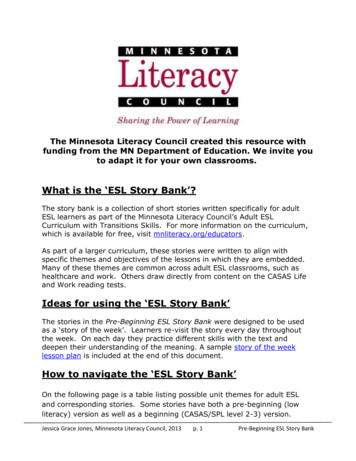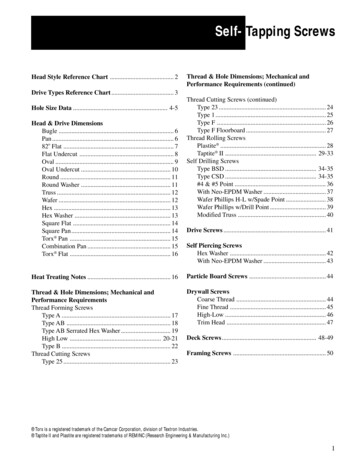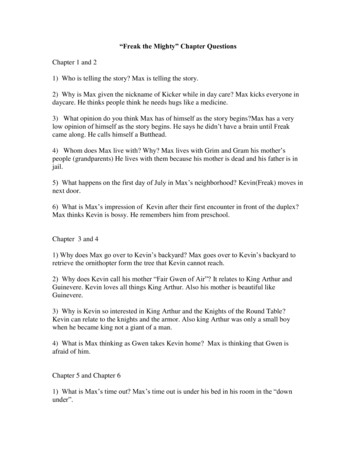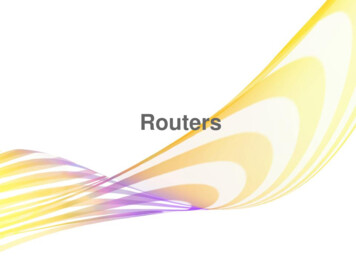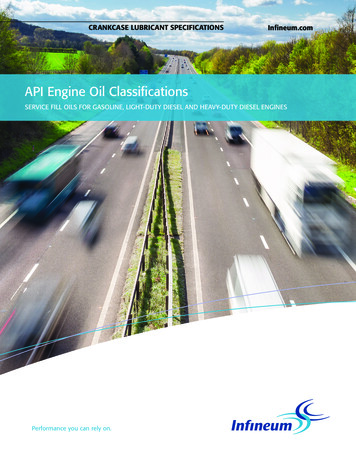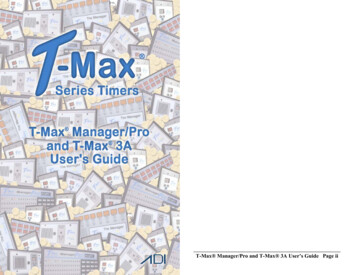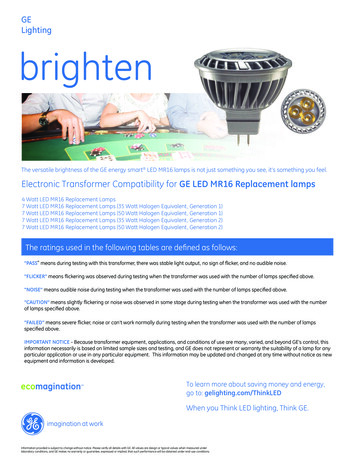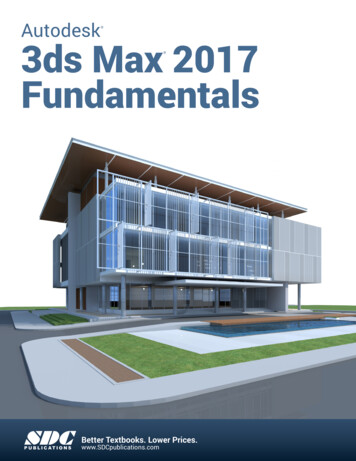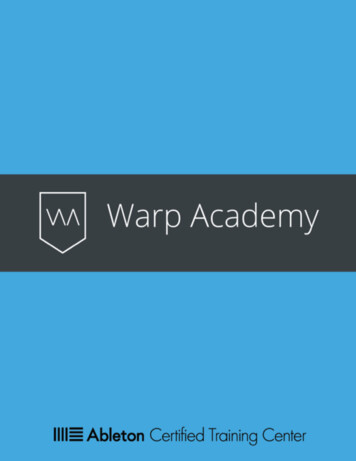
Transcription
An Introduction To Max for Live
Introduction Max for Livep4 What Is Max for Live?p5 How Do I Use Max for Live?p7Expanded Features LFOp9 Multimapp9 Device Randomizerp10Three Incredible Instruments Polip10 Granulator IIp11 More Simplerp11Crazy Effects Buffer Shuffler 2p12 Convolution Reverbp12 Deep Chorusp13Honorable Mentions Multi, Bengal and the Max for Live Connection Kitp14Resourcesp15Warp Academyp16
Here at Warp Academy, we LOVE Max for Live! Whether designing crazy basssounds, creating complex instruments, or connecting Ableton Live to theoutside world, Max for Live is a regular part of our production workflow.We feel like there is a bit of confusion around what Max for Live is, what it cando, and how you can use it, so we thought we’d put together this brief quickstart guide to give you folks a better understanding of this excellent part of theAbleton ecosystem.A lot of our students, upon installing Max for Live, can’t find the devices thatcome included with Live 9 Suite.That’s because they are bundled into Packs, that are freely available inAbleton’s website. Pretty handy, really, as there are quite a lot of devicesavailable from the word go!4
So what is Max for Live?We definitely recommend grabbing the Max for Live Essentials pack, if youhaven’t already, to get started, as well as the Pitch And Time Machines packand anything else that catches your eye Max for Live is an add-on product that greatly expands Live’s features andfunctionality, by allowing you to run a customized version of the program Max/MSP inside Live.5
Max for Live devices are essentially a Max/MSP patch disguised by a familiarand approachable visual interface, meaning we can get using some weird andwonderful toys without having to learn whats going on ‘under the hood’.Max for Live comes included with Suite, so if you already own that, then you’regood to go. Users of Live Standard can upgrade via Ableton’s website toaccess this world of devices and modularity.6
How do I use Max for Live?Max for Live devices, which can be distinguished by their .amxd file type, canbe found in their designated section of Live’s User Library, and can originatefrom a number of places: Packs, both free and premium from Ableton’swebsite, the enormous and mostly-free library at maxforlive.com, fromspecialist companies such as Max for Cats, or from building your own devices.You can essentially use Max for Live, however, you see fit: as a way tocustomize and enhance your Live environment, as a gateway to a constantlyexpanding universe of instruments and effects, or, if you become interested inlearning the relatively simple visual coding language of Max, as a musical swissarmy-knife of infinite possibility.7
Max for Live devices work, for all intents and purposes, just like native Livedevices, meaning you can drag and drop them around your Live project toyour heart’s content, add them to instrument racks and modulate theirparameters in clips or the Live timeline.After dragging a downloaded patch into your Live set, clicking the Save icon onthe top right of the device will copy it to your library. Alternatively, devices thatcome with Packs you have installed are automatically populated into the Maxfor Live section of your User Library.To get you up on your feet, we’ve decided to introduce you to 9 of ourfavourite devices, and in turn shine a light on this wondrous universe of sonicpossibilities 8
Expanded FeaturesSome of our most-loved Max for Live devices are theones that add new features to Live. Here are our top3:1) LFOHave you ever dreamed of quickly andeasily assigning a million parameters toone LFO, a lá Massive or Serum, in Live?Now you can! Not only can you map LFOto just about any parameter in your Liveset (including Master Tempo ), combiningthis device with Instrument Racks andMacro mappings essentially turns Liveinto a endless modular synthesizer.Essential!Pro Tip: Map one LFO to a filter cutoff,and a second LFO to the first one’sRate for complex and evolvingmodulations.2) MultimapA Macro Knob with a difference! Put Multimap on your Master channel (oranywhere you like), and you can map its one Macro Knob to up to 8parameters, on any track, in any device!8
Pro Tip: I really like using thisdevice when I play live. I’ll map the knob to things like filter cutoff, delay andreverb on all of my tracks, so I can turn loops into live arrangements bymanipulating the tension of the music with just one, all-powerful Macro!3) Device RandomizerA great tool for when you hit a wall, or just want to experiment with sounddesign. This device can randomize any native Live device, as well as the Macrosof an instrument rack. As well as 1-click patches when mapped to Operatorsynth (for example), you can modulate the randomization with an internal LFO,leading to some absolutely crazy sounds - try using this with a Grain Delay!Pro Tip: You can use this device with any third-party plugin, selecting theparameters you want to randomize by using the ‘Config’ button, on the topright of the device titlebar.9
Three Incredible InstrumentsExpanding your pallet of sounds 4) PoliPoli is a lush, analog-modeled polyphonic synthesizer that gives a firm nod tosome classic Roland models from the 80s and 90s; this wonderful device isoverlooked at your peril! Like it’s cousin Bass, Poli compliments the excellentnative Live synthesizers Analog and Operator, bringing something distinctlystylized to the table, whilst remaining useable and fun.Pro Tip: Modulate the XMod parameter for some unique textures and movements!CLICK HERE TO WATCH A TUTORIAL ON POLI!10
5) Granulator IIThe funny thing about starting off with granular synthesis is that you keephaving moments of ‘oh, so THATS how you make that sound’! It’s an incrediblyrefreshing approach to sound design that can bring you anything frommorphing drones to twisted Neuro bass wobbles. Granulator II is usable andcomplete in its features, and while perhaps a bit daunting at first, is not sohard to get your head around if you already understand Operator andSimpler. Granulator was created by Robert Henke, one of the original mindsbehind Ableton Live’s evolution.6) More SimplerThis severely under-loved device packs a mean punch for sound design,allowing you to transform banal sounds and loops into enormous granularmovements with just a few macro knobs.Pro Tip: Use More Simpler’s Time and Pitch controls to modulate foley andfield recordings, for mind-bending textures, basses and leads.CLICK HERE TO WATCH A TUTORIAL ON MORE SIMPLER!11
Crazy EffectsSpicing up your instruments and samples 7) Buffer Shuffler 2Instant ideas, instant glitch! Like an array of Beat Repeat devices controlled bya step sequencer, you can dial in the length, stutter and pitch of each step,dial in odd-numbered envelopes for constant variation, or just hammer theDice buttons and let Live write your grooves for you.Pro Tip: Take a long piece of ambience, foley or noise; add Buffer Shuffler,tweak the parameters and boom, a unique percussion loop!8) Convolution ReverbConvolution is a process of filtering one sound through another, and is mostoften used as a way of simulating space. Max for Live’s Convolution Reverbcomes with a huge library of Impulse Response files, or sonic footprints,offering a colorful alternative to Live’s own Reverb device.12
Aside from convincing reverbs, the true depth of convolution is revealedwhen you discover that you can drag any sample from your arrangement, orlibrary, onto the device, and use that as your IR so, want your drums tosound a bit like your synth? Your bass to have a similar tone to your kick?Look no further Pro Tip: drop a pad onto Convolution Reverb, and run some drums andpercussion through it as a new way of generating melodic loops.CLICK HERE TO WATCH A TUTORIAL ON CONVOLUTION REVERB!9) Deep ChorusThis one doesn’t come from an Abletonpack, but rather from the very aptly-namedboutique company Amazing Noises,purveyors of next-level, intricatelyprogrammed instruments and effects suchas Dark Synth and Outer Spaces.Deep Chorus is exactly what it says on thetin, a deep and layered chorus device withparticular and warm character. This is oneof many awesome freebies available onAmazing Noises’ website.13
Honorable MentionsWe couldn’t condense our list to only ninedevices, there’s so much out there! These threedeserve a shout-out MultiSibling to Poli and Bass from the Max for Live EssentialsPack, this quirky and intuitive multi-mode synthesizer is agreat compositional tool.CLICK HERE TO WATCH A TUTORIAL ON MULTI!BengalThis is one of our favorite plugins from Max for Cats, afantastically innovative company pushing the forefront ofthe Max for Live game.Merging the usability of Operator with the depth andcomplexity of FM8, this is an FM synthesizer fromanother planet. The quality of sound from the oscillatorsand filters is absurd, and its excellent GUI make thissynth a sound design weapon.Max for Live Connection KitA fascinating free pack of toys and tools from Ableton,allowing you to intuitively and easily connect Live tothings like your Webcam, Arduino micro-computers, OSCand even robotic Lego bricks!14
ResourcesIf this short introduction has tickled yourcuriosity, and you want to dive deeper, here aresome handy resources we can vouch for Max for Live TutorialsAn introduction to Max for Live from Eric Ameres from Learn Max:https://www.youtube.com/watch?v wNb-RSlmIA0A cool video overview from Ableton:https://www.youtube.com/watch?v nnbhHS6FLDoThe Max for Live page of Cycling74’s website, where you can find some excellent e/#.WMq9zhiZNE5An excellent overview of MaxMSP, showing some of the crazy things it can /SwagFree and premium devices on Ableton’s website:https://www.ableton.com/en/packs/#?item type max for liveThe one and only MaxForLive.comhttp://www.maxforlive.comAmazing free devices from Robert Henkehttp://roberthenke.com/technology/m4l.htmlMax for Catshttp://maxforcats.comAmazing khttps://isotonikstudios.com15
Warp AcademyLearn music production with Ableton Certified Trainers:https://www.warpacademy.comSubscribe to us on Youtube:http://youtube.com/warpacademySay hello on Facebook:http://facebook.com/warpacademyAbout The AuthorMerlyn Silva is a musician, educator and sound artist living inAarhus, Denmark. Cutting his teeth as a guitarist in the early 00’stouring with a string of rock and dub groups, Merlyn later took aleft turn at the crossroads and enrolled to study theatre in 2006.Shortly after, he stumbled into Ableton Live whilst working on aproduction, in a search for a more elegant backing-track solutionthan a CD. He has been mesmerized with the software ever since.Merlyn’s academic history includes a Bachelors degree in Theatrefrom the University of Exeter (UK), and a Masters degree inElectronic Music from the Danish Royal Academy of Music (DIEM),where he is currently completing a Postgraduate Diploma. After 10years of using Live, Merlyn became an Ableton Certified Trainer inJuly 2016. Merlyn currently divides his time between teaching,performing, and promoting niche electronic music concerts in hisadopted Scandinavian hometown.16
Ableton ecosystem. A lot of our students, upon installing Max for Live, can’t find the devices that come included with Live 9 Suite. That’s because they are bundled into Packs, that are freely available in Ableton’s website. Pretty handy, really, as there
